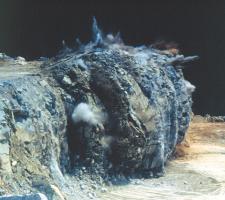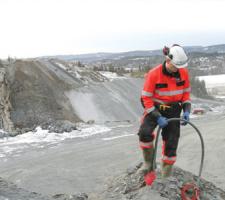
Blasting in European quarries has an excellent safety record thanks to rigorous checks and training and the latest security initiatives are also helping to boost safety. Claire Symes reports
Problems with noise and vibration from drilling and blasting are causing some quarries to consider ripping or hydraulic breakers for primary breaking in Europe. However, since most quarries deal with hard rock, blasting is still an essential tool, so explosives are likely to remain part and parcel of aggregate production.
While the need for explosives in quarries has not changed significantly, the demand placed on the handling and use of them has. Use of computer simulation of blasts and electronic detonators is making blasting more accurate and reducing environmental impact. The need for secure transfer is also influencing how quarries use explosives.
The focus of these changes may be driven by improving security, efficiency and the environmental aspects, but each of these factors is helping to further improve the safety of drilling and blasting work.
"Explosives are the cheapest and most efficient tool for breaking rock and that is unlikely to change in the near future," said Orica vice president of health and safety Dallas Wilkinson. "The real challenge facing the use of explosives is managing the environmental impact of blasting along with the security." Dealing with the environmental and security aspects of explosives use in quarries may not be directly about safety but it has a knock-on positive effect on reducing the risk of accidents.
Vibration value
"Predictive vibration modelling in combination with precise electronic detonator timing capabilities has also led to significant improvements in vibration and airblast control. Computer-based blast design also helps to improve blast efficiency. The result is less fly-rock, which puts the workers in the quarry at a lower risk of accidents," explained Wilkinson.
"One of the key developments in being able to achieve this has been the wider uptake of electronic detonators. These help prevent mis-fires and ensure that the blasting sequence occurs one hole at a time and in the right sequence to give better rock fragmentation and lower air blast and vibration." Before the introduction of electronic detonators, chemically controlled delay elements were the norm and the firing sequence was difficult to check once set up which sometimes caused an overlap in timing. Electronic systems are not only more accurate when it comes to the timing, but can also be checked ahead of blasting and systems can be equipped with security.
The added security on electronic detonators means that the system cannot be set off accidentally or by unqualified staff, which has helped improve safety within the quarry.
Security
The higher risk of terrorism around the world has impacted on the drilling and blasting sector and placed more responsibility on quarries to track and trace the explosives they use. Some areas of Spain and Ireland already force all explosives to be transported under escort but new regulations will tighten security further.
In April the EU announced new tighter regulations for non-military use of explosives to make them more traceable. The new rules will require makers of explosives to mark each package with an identifying label containing information on the country of production, the importing country, the manufacturer and a unique product code. Explosives manufacturers, consumers and shippers will have to keep records for 10 years to ensure that people holding the explosives can be identified.
The traceability need also extends to the detonators and, according to Wilkinson, the industry is taking a cradle to grave approach and is working towards tracking the movements of all detonators.
The heightened security is influencing the type of explosives that are used in Europe and also has a beneficial impact for safety aspects of handling the materials.
"Traditionally Europe's quarrying industry has used packaged explosives but there is now a trend towards using bulk products, which offer fewer risks when it comes to security and also offer a higher margin of safety," said Wilkinson. "The packaged explosives are delivered to site ready to use in the right quantities and are classified as Class 1 explosives. Bulk products, which are commonly used by the mining sector, are mixed on site just before they are pumped into the blast hole using mobile explosives manufacturing units (MEMUs) and are classified as Class 5 materials during transport." Bulk materials are not only safer in explosive terms but also present lower risk to workers on site in terms of manual handling of packaged products where cases can weigh up to 25kg. In contrast, bulk materials which are contained within the MEMU are dispensed straight into the blast hole.
The size of blasts used in many European quarries has also had a beneficial impact on safety. "Blasts carried out in quarries in Europe are generally much smaller than those used in Australia or the US," said Wilkinson. "Larger blasts can lead to reduced blast frequency with the effect of reducing oversized material."
Safety statistics
Use of explosives in quarries is potentially very dangerous if correct procedures are not followed and reports of accidents caused by the mis-use of explosives in less developed countries are common. While there are no accurate figures on the safety of explosives use in quarries in Europe, accidents are rare and the industry is generally associated with a good level of safety.
Widespread use of risk assessment techniques in the European quarrying sector has helped the drilling and blasting industry to achieve good standards. Rigorous enforcement of only allowing qualified and competent staff to carry out blasting work has also helped to raise standards.
"The training for shot firers not only covers the actual technical and safety aspects of the work but often also focuses on the background of the workers to ensure security," said Wilkinson. "In the US, only US citizens can be permitted to handle explosives and in Germany background checks are routine." Nonetheless, continuous training is essential to ensure shot firers are equipped with the right skills and have a clear understanding of the materials they are using.
"We work with the quarry operators to audit their use of explosives and look at every element of the drilling and blasting process to try and improve both efficiency and safety," said Wilkinson. "We are also legal trainers in some countries in Europe and can offer courses for shot firing and surveying, as well as specific training on techniques such as vibration modelling.
"We also organise international courses to bring quarrying companies from around the world together. This gives them an independent forum to discuss issues and problems facing the industry as well as transfer of best practice and new techniques." While it is clear that the blasting sector is doing a good job on the safety front, it is important not to become complacent. Regular assessment of methodology in each quarry is important to ensure it is in line with best practice and continuing training for shot firers and explosives engineers is also critical.
















